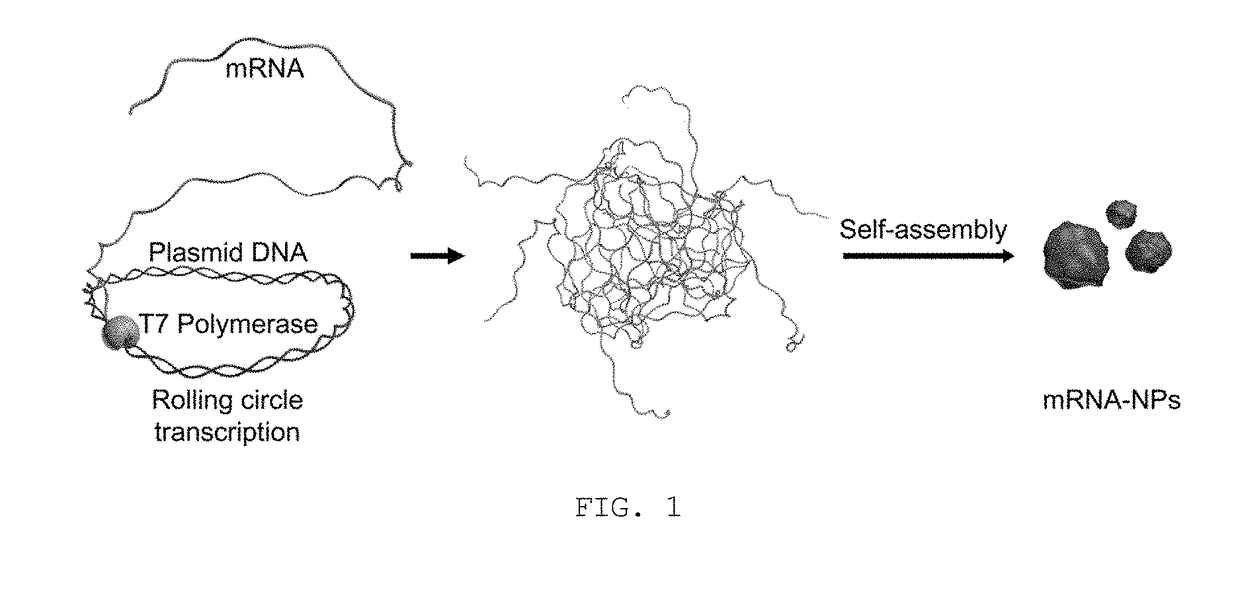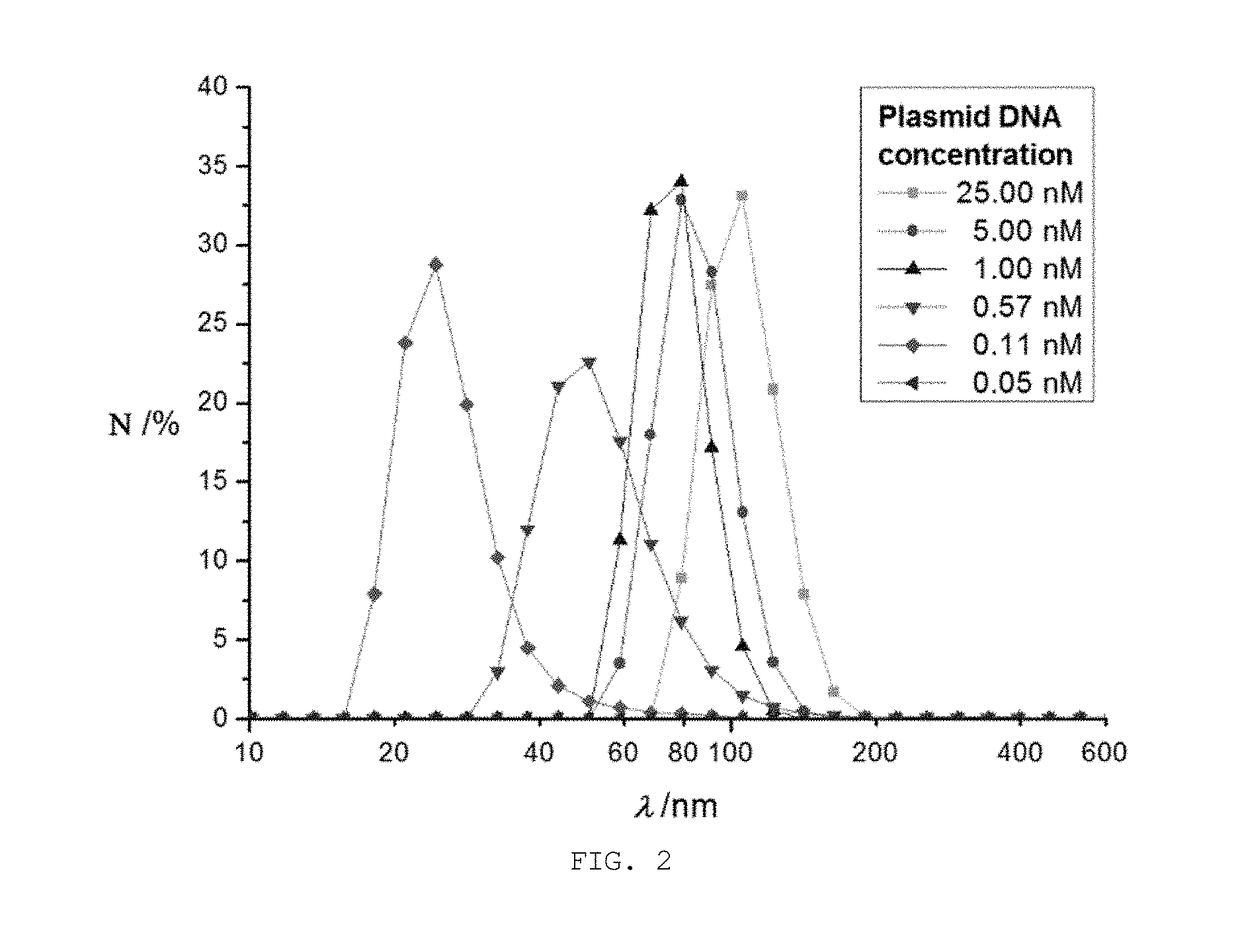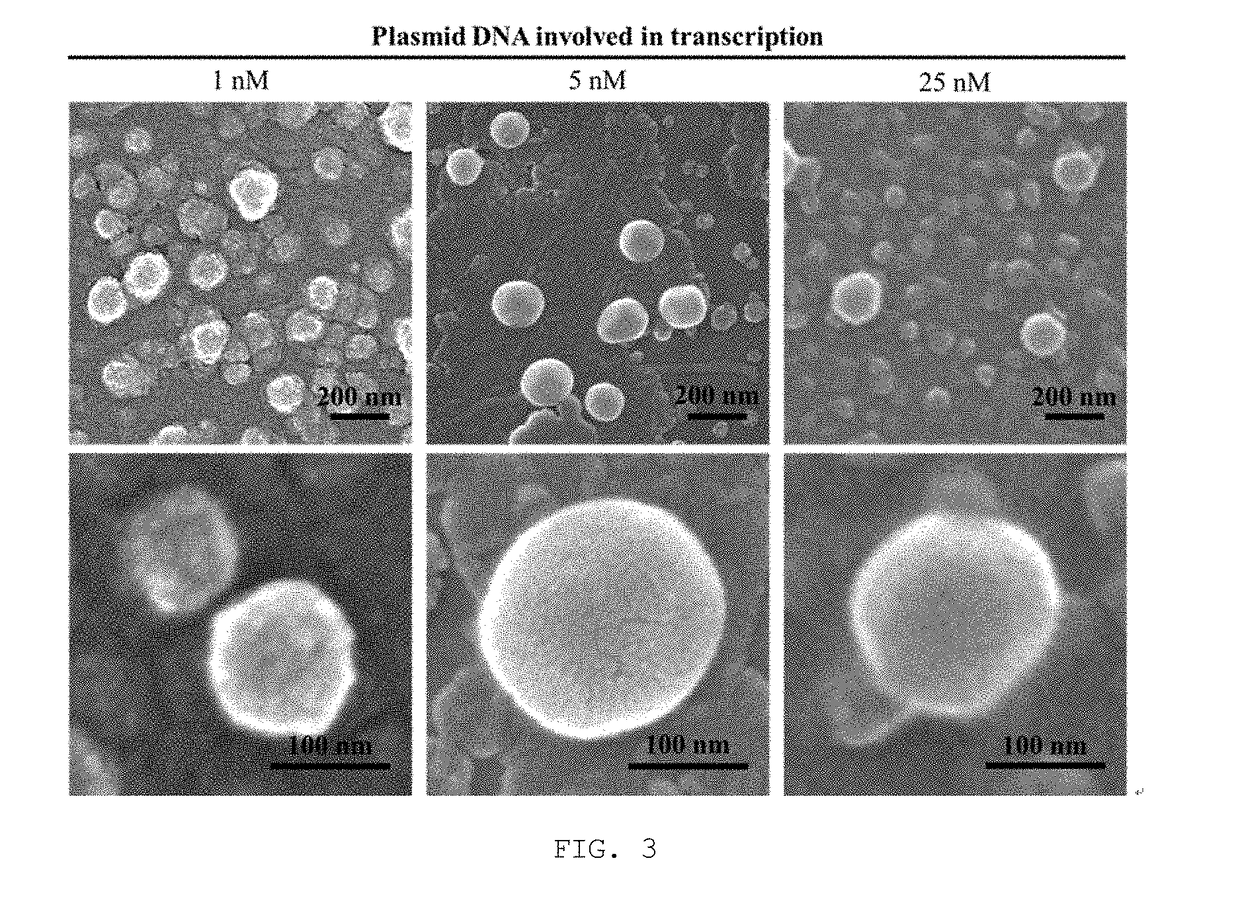Messenger RNA nanoparticles and preparation method therefor
a technology of nanoparticles and nanoparticles, which is applied in the field of nanoparticles, can solve the problems of low efficiency of plasmid dna penetration through the nuclear envelope, risk of genomic integration, and marked reduction of gene expression effectiveness, so as to improve the efficiency of protein expression, enhance the expression of specific proteins, and induce cellular immune responses
- Summary
- Abstract
- Description
- Claims
- Application Information
AI Technical Summary
Benefits of technology
Problems solved by technology
Method used
Image
Examples
example 1
Preparation of Plasmid DNA
[0046]A plasmid DNA as a template for RCT was designed so as to contain a nucleotide sequence (SEQ ID NO: 1) carrying genetic information for expressing a green fluorescent protein, a eukaryotic ribosomal binding sequence (RBS) (SEQ ID NO: 2), known as the Kozak sequence, and a nucleotide sequence (SEQ ID NO: 3) of a promoter region for T7 RNA polymerase, as follows.
CCCGTGTAAAACGACGGCCAGTTTATCTAGTCAGCTTGATTCTAGCTGATCGTGGACCGGAAGGTGAGCCAGTGAGTTGATTGCAGTCCAGTTACGCTGGAGTCTGAGGCTCGTCCTGAATGATATGCGACCGCCGGAGGGTTGCGTTTGAGACGGGCGACAGATCCAGTCGCGCTGCTCTCGTCGATCC-CTATTTGTATAGTTCATCCATGCCATGTGTAATCCCAGCAGCTGTTACAAACTCAAGAAGGACCATGTGGTCTCTCTTTTCGTTGGGATCTTTCGAAAGGGCAGATTGTGTGGACAGGTAATGGTTGTCTGGTAAAAGGACAGGGCCATCGCCAATTGGAGTATTTTGTTGATAATGGTCTGCTAGTTGAACGCTTCCATCTTCAATGTTGTGTCTAATTTTGAAGTTAACTTTGATTCCATTCTTTTGTTTGTCTGCCATGATGTATACATTGTGTGAGTTATAGTTGTATTCCAATTTGTGTCCAAGAATGTTTCCATCTTCTTTAAAATCAATACCTTTTAACTCGATTCTATTAACAAGGGTATCACCTTCAAACTTGACTTCAGCACGTGTCTTGTAGTTCCCGTC...
example 2
Preparation of mRNA Nanoparticles
[0047]1 nM of the plasmid DNA prepared in Example 1 was mixed in a tube with 4 mM of Ribonucleotide Solution Mix (Bioline), Reaction buffer (8 mM Tris-HCl, 0.4 mM spermidine, 1.2 mM MgCl2 and 2 mM dithiothreitol), and 50 units / ml of T7 RNA polymerase (New England Biolabs). The mixture was then incubated at 37° C. for 20 hrs to generate transcripts from the plasmid DNA via rolling circle transcription (RCT), thus yielding mRNA nanoparticles (hereinafter, referred to as ‘mRNA-NPs’).
example 3
Evaluation for Size Distribution of mRNA Nanoparticles Transcribed from Various Concentrations of Plasmid DNA
[0048]1) mRNA nanoparticles were prepared according to the same procedure as in Example 2 with various concentrations (0.05 nM, 0.11 nM, 0.57 nM, 5.00 nM and 25.00 nM) of plasmid DNA.
[0049]2) The mRNA nanoparticles prepared in Examples 2 and 3-1) were analyzed by dynamic light scattering analysis (Particle Size Analyzer WI30i), and the results are given in FIG. 2. Nanoparticles generated with 1 nM, 5 nM and 25 nM of plasmid DNA were also observed by scanning electron microscopy (SEM), and SEM images are given in FIG. 3.
[0050]3) As shown in FIGS. 2 and 3, nanoparticles were not famed when the plasmid DNA was used at a concentration of 0.05 nM or less. Nanoparticles famed with 0.11 nM or more of plasmid DNA were found to have a diameter ranging from 30 to 200 nm while the diameter increased with increasing concentrations of plasmid DNA, but with plasmid DNA of higher than 5 nM,...
PUM
| Property | Measurement | Unit |
|---|---|---|
| diameter | aaaaa | aaaaa |
| diameter | aaaaa | aaaaa |
| diameter | aaaaa | aaaaa |
Abstract
Description
Claims
Application Information
 Login to View More
Login to View More - R&D
- Intellectual Property
- Life Sciences
- Materials
- Tech Scout
- Unparalleled Data Quality
- Higher Quality Content
- 60% Fewer Hallucinations
Browse by: Latest US Patents, China's latest patents, Technical Efficacy Thesaurus, Application Domain, Technology Topic, Popular Technical Reports.
© 2025 PatSnap. All rights reserved.Legal|Privacy policy|Modern Slavery Act Transparency Statement|Sitemap|About US| Contact US: help@patsnap.com



